Leadership Reflection: Healthcare Department Analysis
VerifiedAdded on 2022/10/19
|10
|2956
|450
Report
AI Summary
This report provides a comprehensive reflection on leadership within a healthcare environment, specifically focusing on the orthotics service. The student identifies their leadership strengths and areas for development, analyzing their approach to leadership styles, and implementing various theories and models. The report discusses the importance of adaptive leadership in response to rapid changes, the challenges faced, and the application of Fielder's Contingency model, McGregor's theory, and Blake and Mouton's model. An action plan is developed to improve time management, conflict resolution, and self-confidence. The student emphasizes the significance of inspirational qualities, credibility, and a team management approach to leadership. This report offers valuable insights into the practical application of leadership principles within a healthcare setting and provides a roadmap for future development.
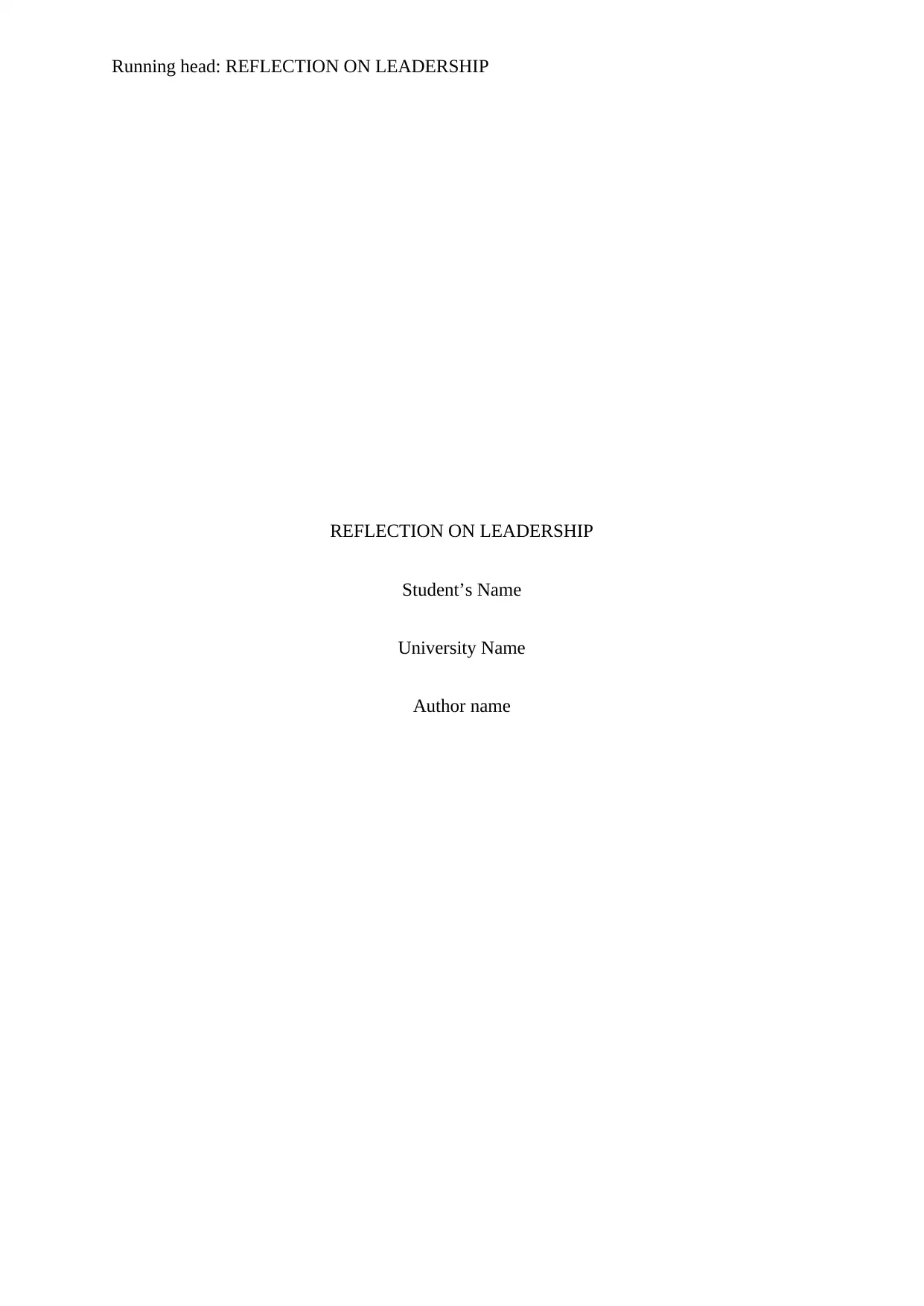
Running head: REFLECTION ON LEADERSHIP
REFLECTION ON LEADERSHIP
Student’s Name
University Name
Author name
REFLECTION ON LEADERSHIP
Student’s Name
University Name
Author name
Paraphrase This Document
Need a fresh take? Get an instant paraphrase of this document with our AI Paraphraser
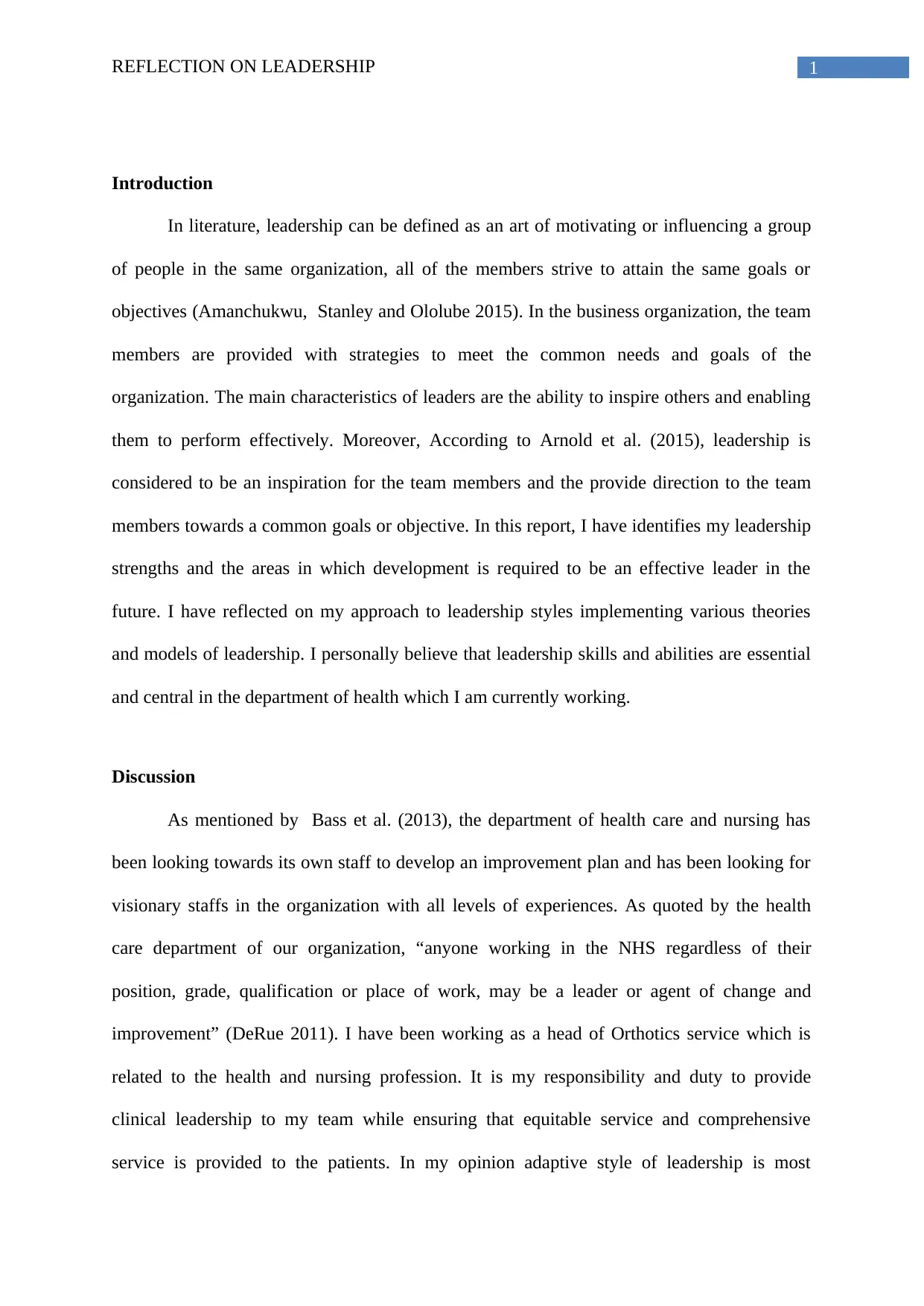
1REFLECTION ON LEADERSHIP
Introduction
In literature, leadership can be defined as an art of motivating or influencing a group
of people in the same organization, all of the members strive to attain the same goals or
objectives (Amanchukwu, Stanley and Ololube 2015). In the business organization, the team
members are provided with strategies to meet the common needs and goals of the
organization. The main characteristics of leaders are the ability to inspire others and enabling
them to perform effectively. Moreover, According to Arnold et al. (2015), leadership is
considered to be an inspiration for the team members and the provide direction to the team
members towards a common goals or objective. In this report, I have identifies my leadership
strengths and the areas in which development is required to be an effective leader in the
future. I have reflected on my approach to leadership styles implementing various theories
and models of leadership. I personally believe that leadership skills and abilities are essential
and central in the department of health which I am currently working.
Discussion
As mentioned by Bass et al. (2013), the department of health care and nursing has
been looking towards its own staff to develop an improvement plan and has been looking for
visionary staffs in the organization with all levels of experiences. As quoted by the health
care department of our organization, “anyone working in the NHS regardless of their
position, grade, qualification or place of work, may be a leader or agent of change and
improvement” (DeRue 2011). I have been working as a head of Orthotics service which is
related to the health and nursing profession. It is my responsibility and duty to provide
clinical leadership to my team while ensuring that equitable service and comprehensive
service is provided to the patients. In my opinion adaptive style of leadership is most
Introduction
In literature, leadership can be defined as an art of motivating or influencing a group
of people in the same organization, all of the members strive to attain the same goals or
objectives (Amanchukwu, Stanley and Ololube 2015). In the business organization, the team
members are provided with strategies to meet the common needs and goals of the
organization. The main characteristics of leaders are the ability to inspire others and enabling
them to perform effectively. Moreover, According to Arnold et al. (2015), leadership is
considered to be an inspiration for the team members and the provide direction to the team
members towards a common goals or objective. In this report, I have identifies my leadership
strengths and the areas in which development is required to be an effective leader in the
future. I have reflected on my approach to leadership styles implementing various theories
and models of leadership. I personally believe that leadership skills and abilities are essential
and central in the department of health which I am currently working.
Discussion
As mentioned by Bass et al. (2013), the department of health care and nursing has
been looking towards its own staff to develop an improvement plan and has been looking for
visionary staffs in the organization with all levels of experiences. As quoted by the health
care department of our organization, “anyone working in the NHS regardless of their
position, grade, qualification or place of work, may be a leader or agent of change and
improvement” (DeRue 2011). I have been working as a head of Orthotics service which is
related to the health and nursing profession. It is my responsibility and duty to provide
clinical leadership to my team while ensuring that equitable service and comprehensive
service is provided to the patients. In my opinion adaptive style of leadership is most
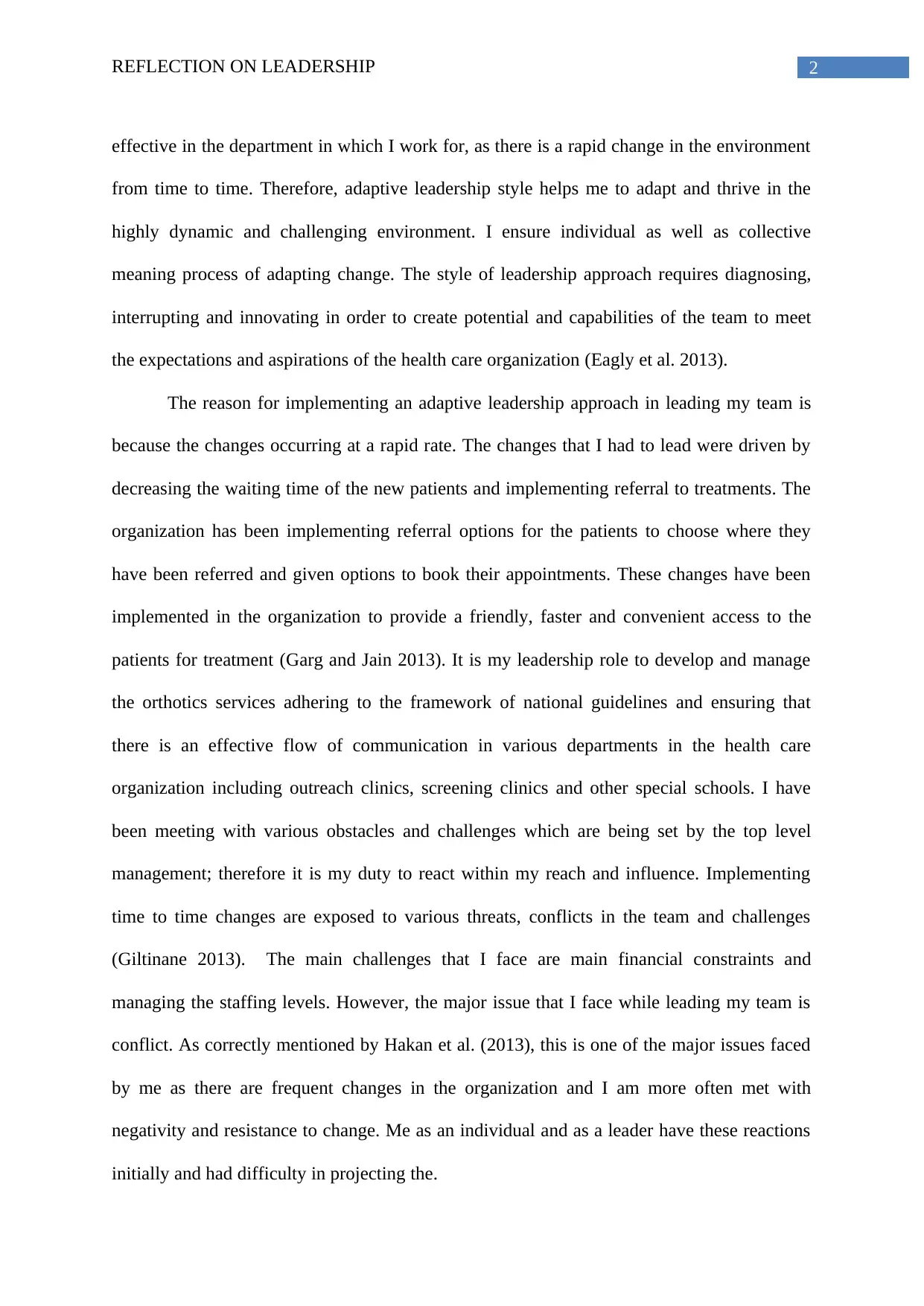
2REFLECTION ON LEADERSHIP
effective in the department in which I work for, as there is a rapid change in the environment
from time to time. Therefore, adaptive leadership style helps me to adapt and thrive in the
highly dynamic and challenging environment. I ensure individual as well as collective
meaning process of adapting change. The style of leadership approach requires diagnosing,
interrupting and innovating in order to create potential and capabilities of the team to meet
the expectations and aspirations of the health care organization (Eagly et al. 2013).
The reason for implementing an adaptive leadership approach in leading my team is
because the changes occurring at a rapid rate. The changes that I had to lead were driven by
decreasing the waiting time of the new patients and implementing referral to treatments. The
organization has been implementing referral options for the patients to choose where they
have been referred and given options to book their appointments. These changes have been
implemented in the organization to provide a friendly, faster and convenient access to the
patients for treatment (Garg and Jain 2013). It is my leadership role to develop and manage
the orthotics services adhering to the framework of national guidelines and ensuring that
there is an effective flow of communication in various departments in the health care
organization including outreach clinics, screening clinics and other special schools. I have
been meeting with various obstacles and challenges which are being set by the top level
management; therefore it is my duty to react within my reach and influence. Implementing
time to time changes are exposed to various threats, conflicts in the team and challenges
(Giltinane 2013). The main challenges that I face are main financial constraints and
managing the staffing levels. However, the major issue that I face while leading my team is
conflict. As correctly mentioned by Hakan et al. (2013), this is one of the major issues faced
by me as there are frequent changes in the organization and I am more often met with
negativity and resistance to change. Me as an individual and as a leader have these reactions
initially and had difficulty in projecting the.
effective in the department in which I work for, as there is a rapid change in the environment
from time to time. Therefore, adaptive leadership style helps me to adapt and thrive in the
highly dynamic and challenging environment. I ensure individual as well as collective
meaning process of adapting change. The style of leadership approach requires diagnosing,
interrupting and innovating in order to create potential and capabilities of the team to meet
the expectations and aspirations of the health care organization (Eagly et al. 2013).
The reason for implementing an adaptive leadership approach in leading my team is
because the changes occurring at a rapid rate. The changes that I had to lead were driven by
decreasing the waiting time of the new patients and implementing referral to treatments. The
organization has been implementing referral options for the patients to choose where they
have been referred and given options to book their appointments. These changes have been
implemented in the organization to provide a friendly, faster and convenient access to the
patients for treatment (Garg and Jain 2013). It is my leadership role to develop and manage
the orthotics services adhering to the framework of national guidelines and ensuring that
there is an effective flow of communication in various departments in the health care
organization including outreach clinics, screening clinics and other special schools. I have
been meeting with various obstacles and challenges which are being set by the top level
management; therefore it is my duty to react within my reach and influence. Implementing
time to time changes are exposed to various threats, conflicts in the team and challenges
(Giltinane 2013). The main challenges that I face are main financial constraints and
managing the staffing levels. However, the major issue that I face while leading my team is
conflict. As correctly mentioned by Hakan et al. (2013), this is one of the major issues faced
by me as there are frequent changes in the organization and I am more often met with
negativity and resistance to change. Me as an individual and as a leader have these reactions
initially and had difficulty in projecting the.
⊘ This is a preview!⊘
Do you want full access?
Subscribe today to unlock all pages.

Trusted by 1+ million students worldwide
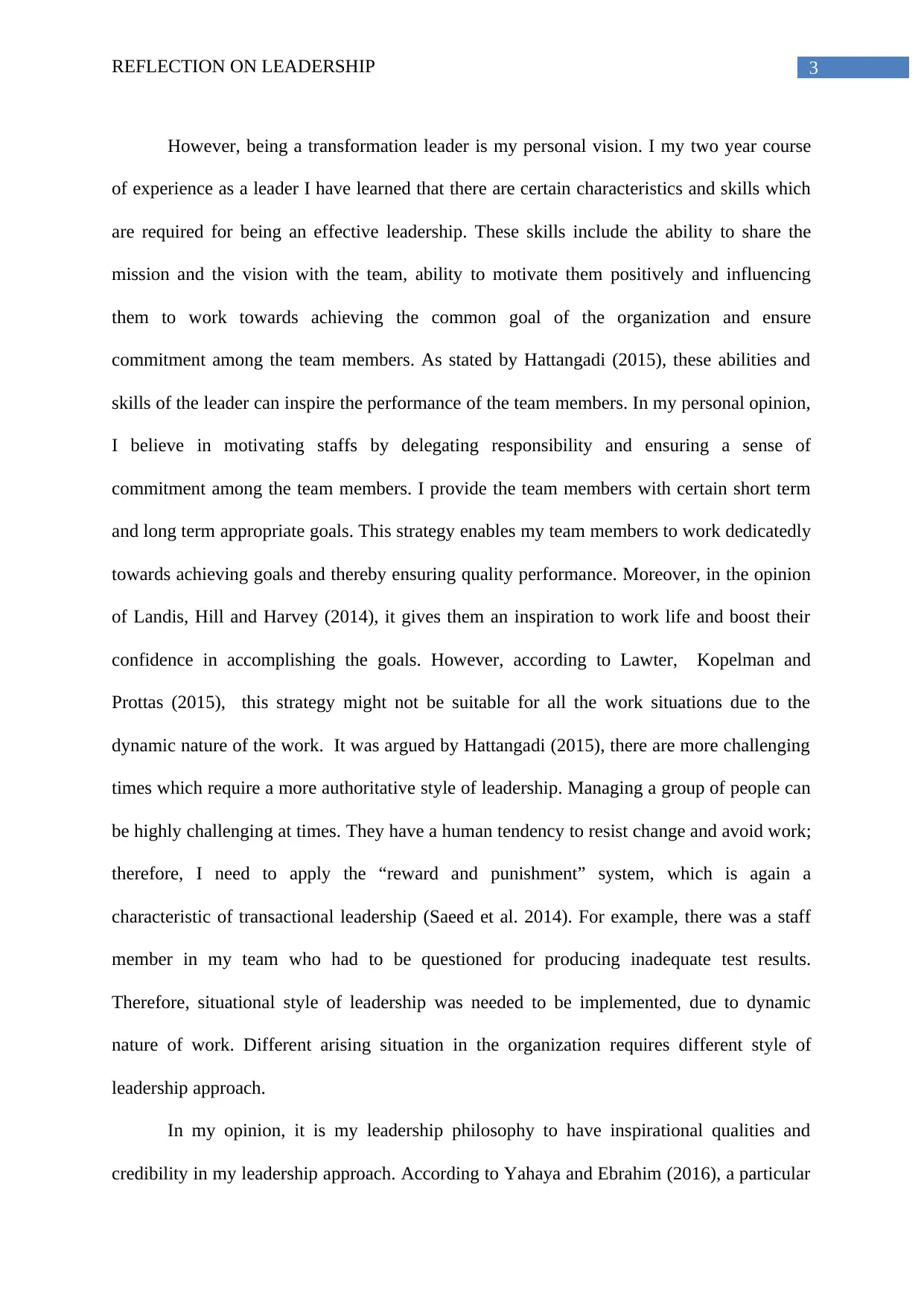
3REFLECTION ON LEADERSHIP
However, being a transformation leader is my personal vision. I my two year course
of experience as a leader I have learned that there are certain characteristics and skills which
are required for being an effective leadership. These skills include the ability to share the
mission and the vision with the team, ability to motivate them positively and influencing
them to work towards achieving the common goal of the organization and ensure
commitment among the team members. As stated by Hattangadi (2015), these abilities and
skills of the leader can inspire the performance of the team members. In my personal opinion,
I believe in motivating staffs by delegating responsibility and ensuring a sense of
commitment among the team members. I provide the team members with certain short term
and long term appropriate goals. This strategy enables my team members to work dedicatedly
towards achieving goals and thereby ensuring quality performance. Moreover, in the opinion
of Landis, Hill and Harvey (2014), it gives them an inspiration to work life and boost their
confidence in accomplishing the goals. However, according to Lawter, Kopelman and
Prottas (2015), this strategy might not be suitable for all the work situations due to the
dynamic nature of the work. It was argued by Hattangadi (2015), there are more challenging
times which require a more authoritative style of leadership. Managing a group of people can
be highly challenging at times. They have a human tendency to resist change and avoid work;
therefore, I need to apply the “reward and punishment” system, which is again a
characteristic of transactional leadership (Saeed et al. 2014). For example, there was a staff
member in my team who had to be questioned for producing inadequate test results.
Therefore, situational style of leadership was needed to be implemented, due to dynamic
nature of work. Different arising situation in the organization requires different style of
leadership approach.
In my opinion, it is my leadership philosophy to have inspirational qualities and
credibility in my leadership approach. According to Yahaya and Ebrahim (2016), a particular
However, being a transformation leader is my personal vision. I my two year course
of experience as a leader I have learned that there are certain characteristics and skills which
are required for being an effective leadership. These skills include the ability to share the
mission and the vision with the team, ability to motivate them positively and influencing
them to work towards achieving the common goal of the organization and ensure
commitment among the team members. As stated by Hattangadi (2015), these abilities and
skills of the leader can inspire the performance of the team members. In my personal opinion,
I believe in motivating staffs by delegating responsibility and ensuring a sense of
commitment among the team members. I provide the team members with certain short term
and long term appropriate goals. This strategy enables my team members to work dedicatedly
towards achieving goals and thereby ensuring quality performance. Moreover, in the opinion
of Landis, Hill and Harvey (2014), it gives them an inspiration to work life and boost their
confidence in accomplishing the goals. However, according to Lawter, Kopelman and
Prottas (2015), this strategy might not be suitable for all the work situations due to the
dynamic nature of the work. It was argued by Hattangadi (2015), there are more challenging
times which require a more authoritative style of leadership. Managing a group of people can
be highly challenging at times. They have a human tendency to resist change and avoid work;
therefore, I need to apply the “reward and punishment” system, which is again a
characteristic of transactional leadership (Saeed et al. 2014). For example, there was a staff
member in my team who had to be questioned for producing inadequate test results.
Therefore, situational style of leadership was needed to be implemented, due to dynamic
nature of work. Different arising situation in the organization requires different style of
leadership approach.
In my opinion, it is my leadership philosophy to have inspirational qualities and
credibility in my leadership approach. According to Yahaya and Ebrahim (2016), a particular
Paraphrase This Document
Need a fresh take? Get an instant paraphrase of this document with our AI Paraphraser
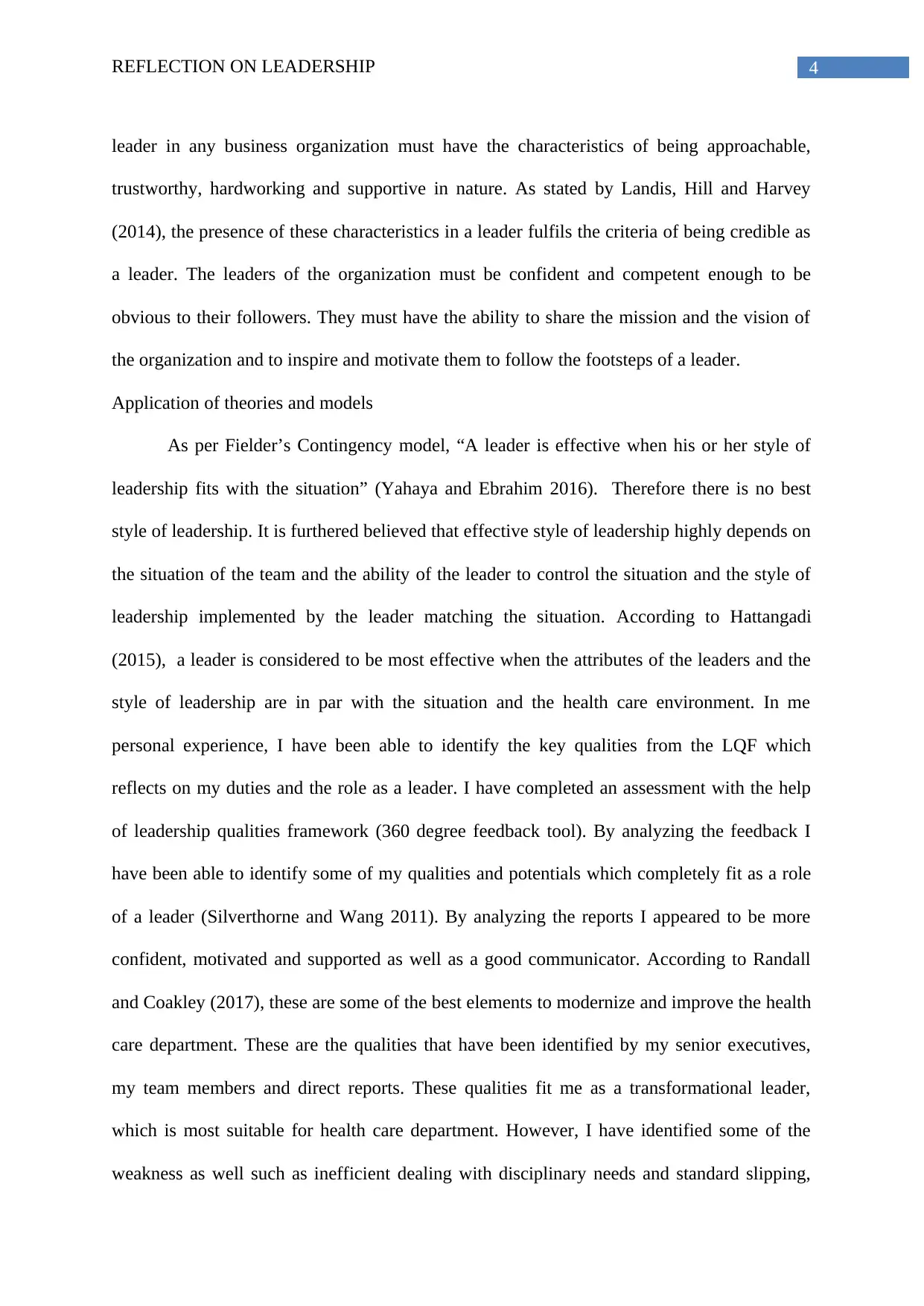
4REFLECTION ON LEADERSHIP
leader in any business organization must have the characteristics of being approachable,
trustworthy, hardworking and supportive in nature. As stated by Landis, Hill and Harvey
(2014), the presence of these characteristics in a leader fulfils the criteria of being credible as
a leader. The leaders of the organization must be confident and competent enough to be
obvious to their followers. They must have the ability to share the mission and the vision of
the organization and to inspire and motivate them to follow the footsteps of a leader.
Application of theories and models
As per Fielder’s Contingency model, “A leader is effective when his or her style of
leadership fits with the situation” (Yahaya and Ebrahim 2016). Therefore there is no best
style of leadership. It is furthered believed that effective style of leadership highly depends on
the situation of the team and the ability of the leader to control the situation and the style of
leadership implemented by the leader matching the situation. According to Hattangadi
(2015), a leader is considered to be most effective when the attributes of the leaders and the
style of leadership are in par with the situation and the health care environment. In me
personal experience, I have been able to identify the key qualities from the LQF which
reflects on my duties and the role as a leader. I have completed an assessment with the help
of leadership qualities framework (360 degree feedback tool). By analyzing the feedback I
have been able to identify some of my qualities and potentials which completely fit as a role
of a leader (Silverthorne and Wang 2011). By analyzing the reports I appeared to be more
confident, motivated and supported as well as a good communicator. According to Randall
and Coakley (2017), these are some of the best elements to modernize and improve the health
care department. These are the qualities that have been identified by my senior executives,
my team members and direct reports. These qualities fit me as a transformational leader,
which is most suitable for health care department. However, I have identified some of the
weakness as well such as inefficient dealing with disciplinary needs and standard slipping,
leader in any business organization must have the characteristics of being approachable,
trustworthy, hardworking and supportive in nature. As stated by Landis, Hill and Harvey
(2014), the presence of these characteristics in a leader fulfils the criteria of being credible as
a leader. The leaders of the organization must be confident and competent enough to be
obvious to their followers. They must have the ability to share the mission and the vision of
the organization and to inspire and motivate them to follow the footsteps of a leader.
Application of theories and models
As per Fielder’s Contingency model, “A leader is effective when his or her style of
leadership fits with the situation” (Yahaya and Ebrahim 2016). Therefore there is no best
style of leadership. It is furthered believed that effective style of leadership highly depends on
the situation of the team and the ability of the leader to control the situation and the style of
leadership implemented by the leader matching the situation. According to Hattangadi
(2015), a leader is considered to be most effective when the attributes of the leaders and the
style of leadership are in par with the situation and the health care environment. In me
personal experience, I have been able to identify the key qualities from the LQF which
reflects on my duties and the role as a leader. I have completed an assessment with the help
of leadership qualities framework (360 degree feedback tool). By analyzing the feedback I
have been able to identify some of my qualities and potentials which completely fit as a role
of a leader (Silverthorne and Wang 2011). By analyzing the reports I appeared to be more
confident, motivated and supported as well as a good communicator. According to Randall
and Coakley (2017), these are some of the best elements to modernize and improve the health
care department. These are the qualities that have been identified by my senior executives,
my team members and direct reports. These qualities fit me as a transformational leader,
which is most suitable for health care department. However, I have identified some of the
weakness as well such as inefficient dealing with disciplinary needs and standard slipping,
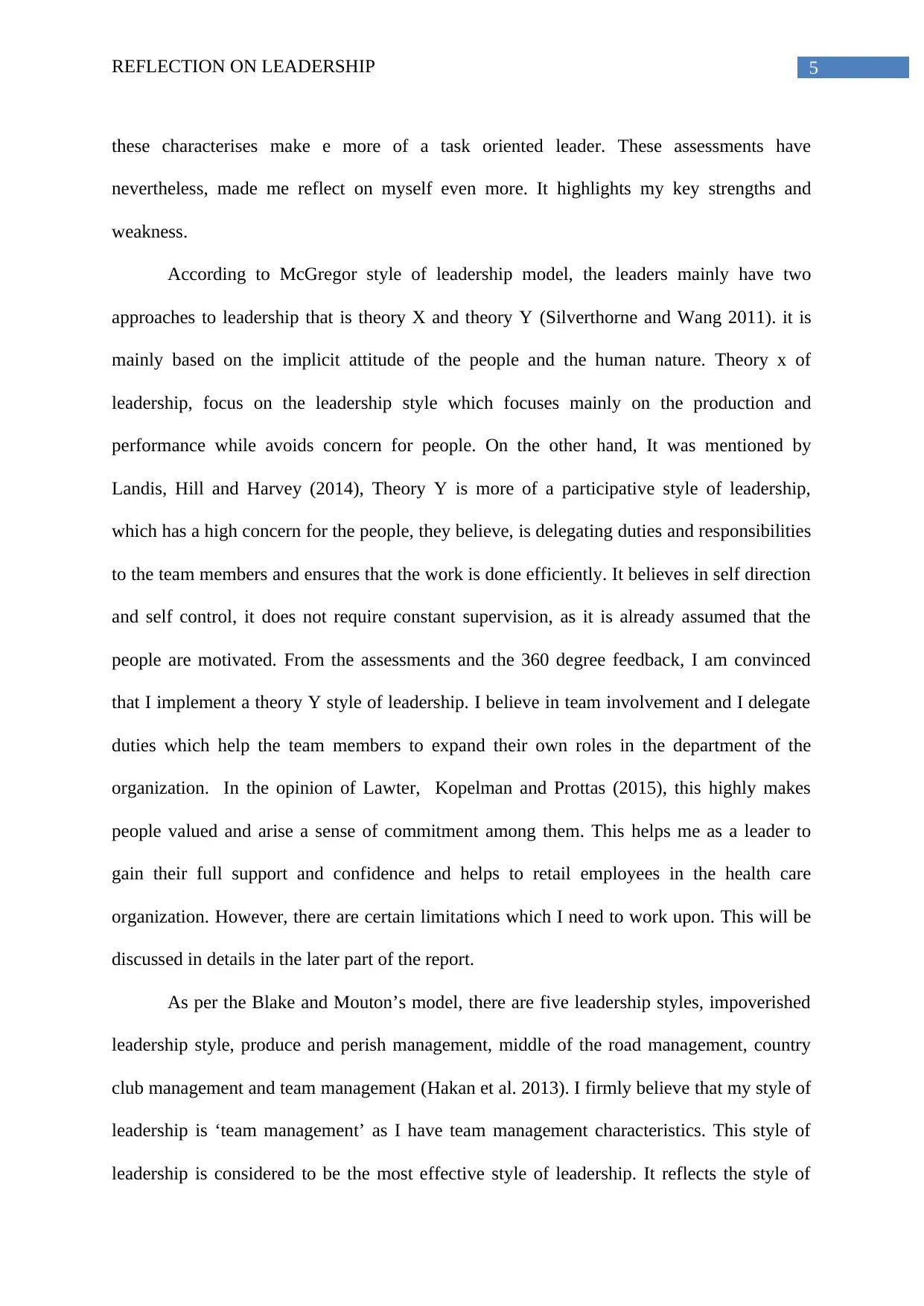
5REFLECTION ON LEADERSHIP
these characterises make e more of a task oriented leader. These assessments have
nevertheless, made me reflect on myself even more. It highlights my key strengths and
weakness.
According to McGregor style of leadership model, the leaders mainly have two
approaches to leadership that is theory X and theory Y (Silverthorne and Wang 2011). it is
mainly based on the implicit attitude of the people and the human nature. Theory x of
leadership, focus on the leadership style which focuses mainly on the production and
performance while avoids concern for people. On the other hand, It was mentioned by
Landis, Hill and Harvey (2014), Theory Y is more of a participative style of leadership,
which has a high concern for the people, they believe, is delegating duties and responsibilities
to the team members and ensures that the work is done efficiently. It believes in self direction
and self control, it does not require constant supervision, as it is already assumed that the
people are motivated. From the assessments and the 360 degree feedback, I am convinced
that I implement a theory Y style of leadership. I believe in team involvement and I delegate
duties which help the team members to expand their own roles in the department of the
organization. In the opinion of Lawter, Kopelman and Prottas (2015), this highly makes
people valued and arise a sense of commitment among them. This helps me as a leader to
gain their full support and confidence and helps to retail employees in the health care
organization. However, there are certain limitations which I need to work upon. This will be
discussed in details in the later part of the report.
As per the Blake and Mouton’s model, there are five leadership styles, impoverished
leadership style, produce and perish management, middle of the road management, country
club management and team management (Hakan et al. 2013). I firmly believe that my style of
leadership is ‘team management’ as I have team management characteristics. This style of
leadership is considered to be the most effective style of leadership. It reflects the style of
these characterises make e more of a task oriented leader. These assessments have
nevertheless, made me reflect on myself even more. It highlights my key strengths and
weakness.
According to McGregor style of leadership model, the leaders mainly have two
approaches to leadership that is theory X and theory Y (Silverthorne and Wang 2011). it is
mainly based on the implicit attitude of the people and the human nature. Theory x of
leadership, focus on the leadership style which focuses mainly on the production and
performance while avoids concern for people. On the other hand, It was mentioned by
Landis, Hill and Harvey (2014), Theory Y is more of a participative style of leadership,
which has a high concern for the people, they believe, is delegating duties and responsibilities
to the team members and ensures that the work is done efficiently. It believes in self direction
and self control, it does not require constant supervision, as it is already assumed that the
people are motivated. From the assessments and the 360 degree feedback, I am convinced
that I implement a theory Y style of leadership. I believe in team involvement and I delegate
duties which help the team members to expand their own roles in the department of the
organization. In the opinion of Lawter, Kopelman and Prottas (2015), this highly makes
people valued and arise a sense of commitment among them. This helps me as a leader to
gain their full support and confidence and helps to retail employees in the health care
organization. However, there are certain limitations which I need to work upon. This will be
discussed in details in the later part of the report.
As per the Blake and Mouton’s model, there are five leadership styles, impoverished
leadership style, produce and perish management, middle of the road management, country
club management and team management (Hakan et al. 2013). I firmly believe that my style of
leadership is ‘team management’ as I have team management characteristics. This style of
leadership is considered to be the most effective style of leadership. It reflects the style of
⊘ This is a preview!⊘
Do you want full access?
Subscribe today to unlock all pages.

Trusted by 1+ million students worldwide
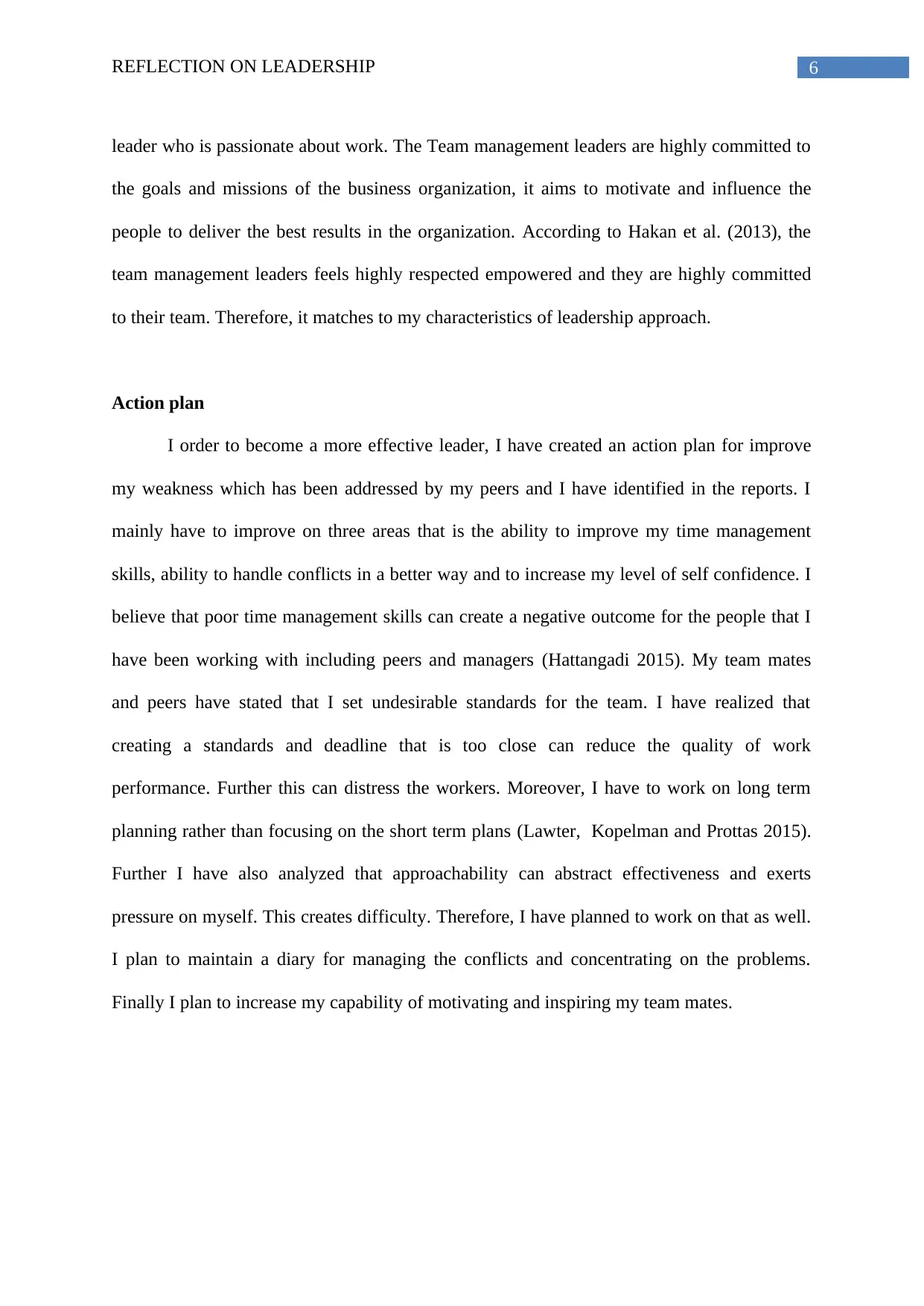
6REFLECTION ON LEADERSHIP
leader who is passionate about work. The Team management leaders are highly committed to
the goals and missions of the business organization, it aims to motivate and influence the
people to deliver the best results in the organization. According to Hakan et al. (2013), the
team management leaders feels highly respected empowered and they are highly committed
to their team. Therefore, it matches to my characteristics of leadership approach.
Action plan
I order to become a more effective leader, I have created an action plan for improve
my weakness which has been addressed by my peers and I have identified in the reports. I
mainly have to improve on three areas that is the ability to improve my time management
skills, ability to handle conflicts in a better way and to increase my level of self confidence. I
believe that poor time management skills can create a negative outcome for the people that I
have been working with including peers and managers (Hattangadi 2015). My team mates
and peers have stated that I set undesirable standards for the team. I have realized that
creating a standards and deadline that is too close can reduce the quality of work
performance. Further this can distress the workers. Moreover, I have to work on long term
planning rather than focusing on the short term plans (Lawter, Kopelman and Prottas 2015).
Further I have also analyzed that approachability can abstract effectiveness and exerts
pressure on myself. This creates difficulty. Therefore, I have planned to work on that as well.
I plan to maintain a diary for managing the conflicts and concentrating on the problems.
Finally I plan to increase my capability of motivating and inspiring my team mates.
leader who is passionate about work. The Team management leaders are highly committed to
the goals and missions of the business organization, it aims to motivate and influence the
people to deliver the best results in the organization. According to Hakan et al. (2013), the
team management leaders feels highly respected empowered and they are highly committed
to their team. Therefore, it matches to my characteristics of leadership approach.
Action plan
I order to become a more effective leader, I have created an action plan for improve
my weakness which has been addressed by my peers and I have identified in the reports. I
mainly have to improve on three areas that is the ability to improve my time management
skills, ability to handle conflicts in a better way and to increase my level of self confidence. I
believe that poor time management skills can create a negative outcome for the people that I
have been working with including peers and managers (Hattangadi 2015). My team mates
and peers have stated that I set undesirable standards for the team. I have realized that
creating a standards and deadline that is too close can reduce the quality of work
performance. Further this can distress the workers. Moreover, I have to work on long term
planning rather than focusing on the short term plans (Lawter, Kopelman and Prottas 2015).
Further I have also analyzed that approachability can abstract effectiveness and exerts
pressure on myself. This creates difficulty. Therefore, I have planned to work on that as well.
I plan to maintain a diary for managing the conflicts and concentrating on the problems.
Finally I plan to increase my capability of motivating and inspiring my team mates.
Paraphrase This Document
Need a fresh take? Get an instant paraphrase of this document with our AI Paraphraser
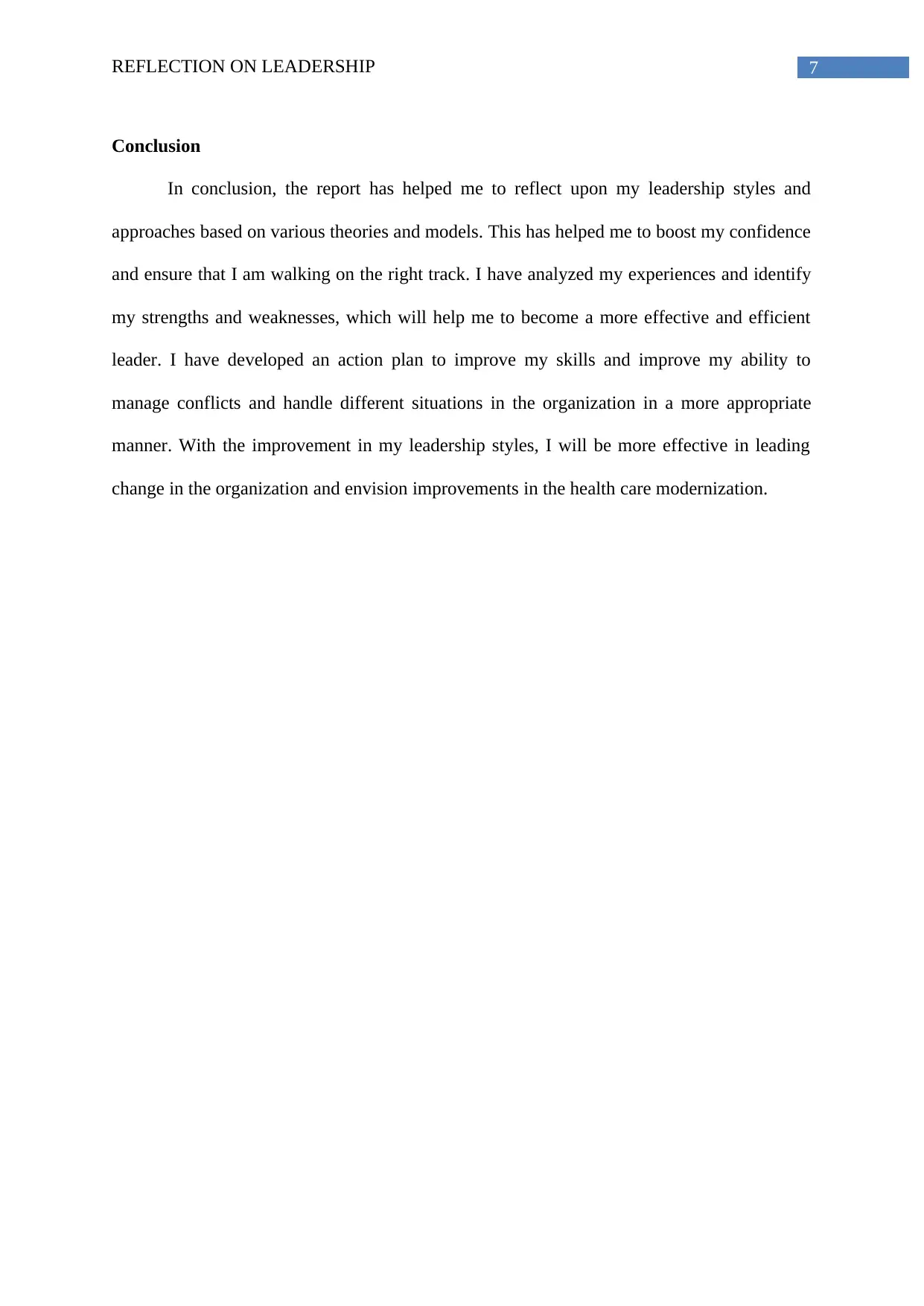
7REFLECTION ON LEADERSHIP
Conclusion
In conclusion, the report has helped me to reflect upon my leadership styles and
approaches based on various theories and models. This has helped me to boost my confidence
and ensure that I am walking on the right track. I have analyzed my experiences and identify
my strengths and weaknesses, which will help me to become a more effective and efficient
leader. I have developed an action plan to improve my skills and improve my ability to
manage conflicts and handle different situations in the organization in a more appropriate
manner. With the improvement in my leadership styles, I will be more effective in leading
change in the organization and envision improvements in the health care modernization.
Conclusion
In conclusion, the report has helped me to reflect upon my leadership styles and
approaches based on various theories and models. This has helped me to boost my confidence
and ensure that I am walking on the right track. I have analyzed my experiences and identify
my strengths and weaknesses, which will help me to become a more effective and efficient
leader. I have developed an action plan to improve my skills and improve my ability to
manage conflicts and handle different situations in the organization in a more appropriate
manner. With the improvement in my leadership styles, I will be more effective in leading
change in the organization and envision improvements in the health care modernization.
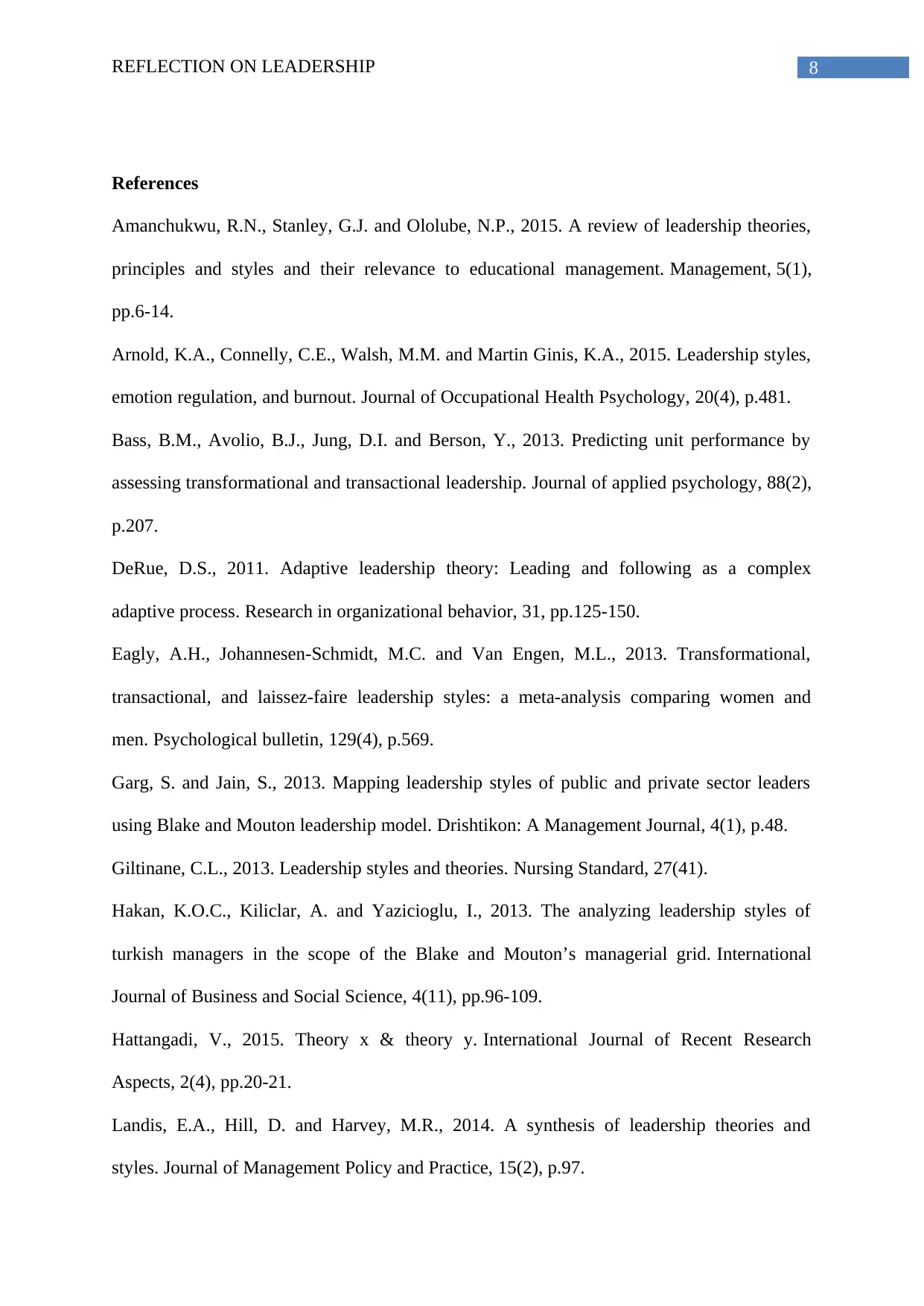
8REFLECTION ON LEADERSHIP
References
Amanchukwu, R.N., Stanley, G.J. and Ololube, N.P., 2015. A review of leadership theories,
principles and styles and their relevance to educational management. Management, 5(1),
pp.6-14.
Arnold, K.A., Connelly, C.E., Walsh, M.M. and Martin Ginis, K.A., 2015. Leadership styles,
emotion regulation, and burnout. Journal of Occupational Health Psychology, 20(4), p.481.
Bass, B.M., Avolio, B.J., Jung, D.I. and Berson, Y., 2013. Predicting unit performance by
assessing transformational and transactional leadership. Journal of applied psychology, 88(2),
p.207.
DeRue, D.S., 2011. Adaptive leadership theory: Leading and following as a complex
adaptive process. Research in organizational behavior, 31, pp.125-150.
Eagly, A.H., Johannesen-Schmidt, M.C. and Van Engen, M.L., 2013. Transformational,
transactional, and laissez-faire leadership styles: a meta-analysis comparing women and
men. Psychological bulletin, 129(4), p.569.
Garg, S. and Jain, S., 2013. Mapping leadership styles of public and private sector leaders
using Blake and Mouton leadership model. Drishtikon: A Management Journal, 4(1), p.48.
Giltinane, C.L., 2013. Leadership styles and theories. Nursing Standard, 27(41).
Hakan, K.O.C., Kiliclar, A. and Yazicioglu, I., 2013. The analyzing leadership styles of
turkish managers in the scope of the Blake and Mouton’s managerial grid. International
Journal of Business and Social Science, 4(11), pp.96-109.
Hattangadi, V., 2015. Theory x & theory y. International Journal of Recent Research
Aspects, 2(4), pp.20-21.
Landis, E.A., Hill, D. and Harvey, M.R., 2014. A synthesis of leadership theories and
styles. Journal of Management Policy and Practice, 15(2), p.97.
References
Amanchukwu, R.N., Stanley, G.J. and Ololube, N.P., 2015. A review of leadership theories,
principles and styles and their relevance to educational management. Management, 5(1),
pp.6-14.
Arnold, K.A., Connelly, C.E., Walsh, M.M. and Martin Ginis, K.A., 2015. Leadership styles,
emotion regulation, and burnout. Journal of Occupational Health Psychology, 20(4), p.481.
Bass, B.M., Avolio, B.J., Jung, D.I. and Berson, Y., 2013. Predicting unit performance by
assessing transformational and transactional leadership. Journal of applied psychology, 88(2),
p.207.
DeRue, D.S., 2011. Adaptive leadership theory: Leading and following as a complex
adaptive process. Research in organizational behavior, 31, pp.125-150.
Eagly, A.H., Johannesen-Schmidt, M.C. and Van Engen, M.L., 2013. Transformational,
transactional, and laissez-faire leadership styles: a meta-analysis comparing women and
men. Psychological bulletin, 129(4), p.569.
Garg, S. and Jain, S., 2013. Mapping leadership styles of public and private sector leaders
using Blake and Mouton leadership model. Drishtikon: A Management Journal, 4(1), p.48.
Giltinane, C.L., 2013. Leadership styles and theories. Nursing Standard, 27(41).
Hakan, K.O.C., Kiliclar, A. and Yazicioglu, I., 2013. The analyzing leadership styles of
turkish managers in the scope of the Blake and Mouton’s managerial grid. International
Journal of Business and Social Science, 4(11), pp.96-109.
Hattangadi, V., 2015. Theory x & theory y. International Journal of Recent Research
Aspects, 2(4), pp.20-21.
Landis, E.A., Hill, D. and Harvey, M.R., 2014. A synthesis of leadership theories and
styles. Journal of Management Policy and Practice, 15(2), p.97.
⊘ This is a preview!⊘
Do you want full access?
Subscribe today to unlock all pages.

Trusted by 1+ million students worldwide
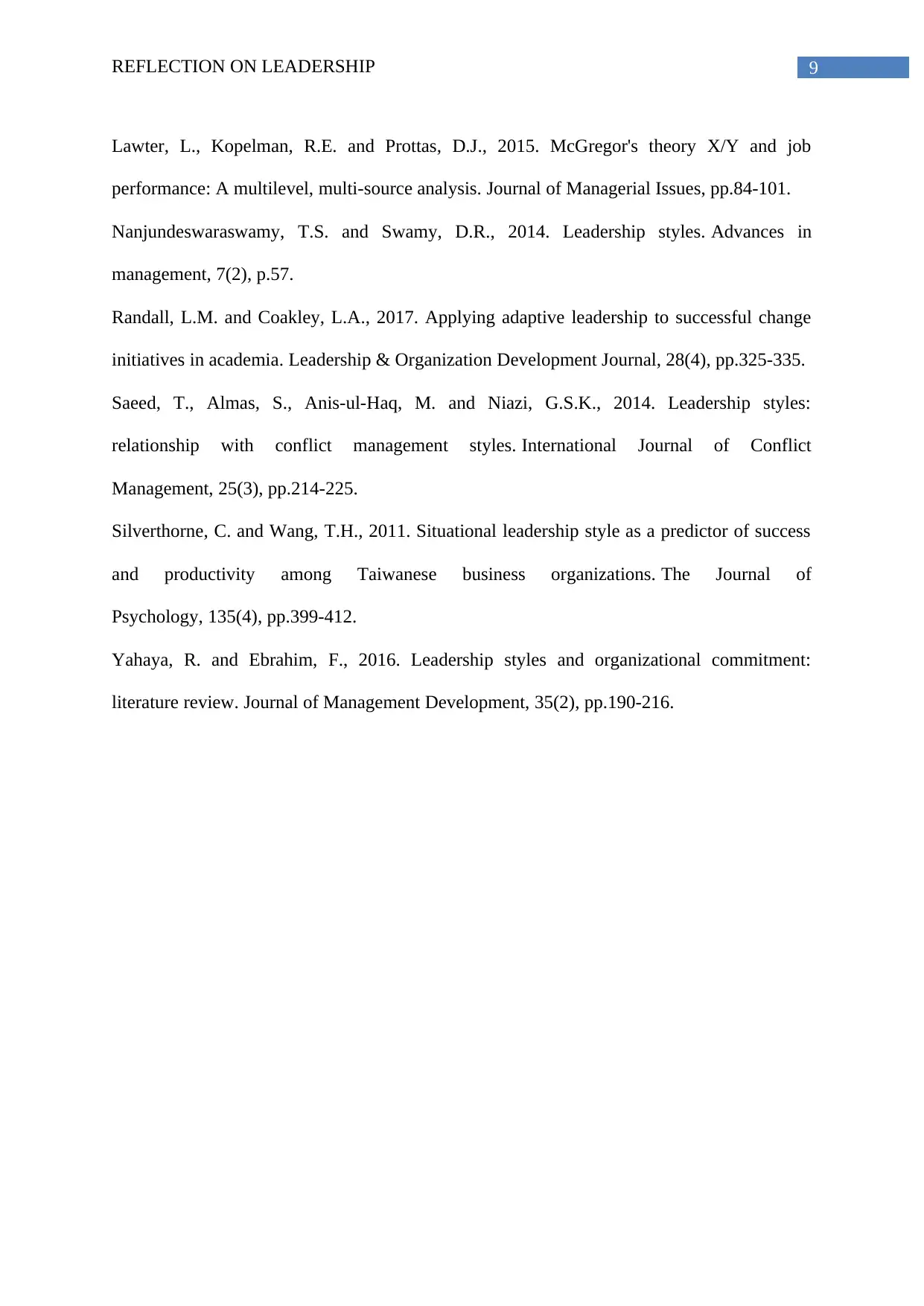
9REFLECTION ON LEADERSHIP
Lawter, L., Kopelman, R.E. and Prottas, D.J., 2015. McGregor's theory X/Y and job
performance: A multilevel, multi-source analysis. Journal of Managerial Issues, pp.84-101.
Nanjundeswaraswamy, T.S. and Swamy, D.R., 2014. Leadership styles. Advances in
management, 7(2), p.57.
Randall, L.M. and Coakley, L.A., 2017. Applying adaptive leadership to successful change
initiatives in academia. Leadership & Organization Development Journal, 28(4), pp.325-335.
Saeed, T., Almas, S., Anis-ul-Haq, M. and Niazi, G.S.K., 2014. Leadership styles:
relationship with conflict management styles. International Journal of Conflict
Management, 25(3), pp.214-225.
Silverthorne, C. and Wang, T.H., 2011. Situational leadership style as a predictor of success
and productivity among Taiwanese business organizations. The Journal of
Psychology, 135(4), pp.399-412.
Yahaya, R. and Ebrahim, F., 2016. Leadership styles and organizational commitment:
literature review. Journal of Management Development, 35(2), pp.190-216.
Lawter, L., Kopelman, R.E. and Prottas, D.J., 2015. McGregor's theory X/Y and job
performance: A multilevel, multi-source analysis. Journal of Managerial Issues, pp.84-101.
Nanjundeswaraswamy, T.S. and Swamy, D.R., 2014. Leadership styles. Advances in
management, 7(2), p.57.
Randall, L.M. and Coakley, L.A., 2017. Applying adaptive leadership to successful change
initiatives in academia. Leadership & Organization Development Journal, 28(4), pp.325-335.
Saeed, T., Almas, S., Anis-ul-Haq, M. and Niazi, G.S.K., 2014. Leadership styles:
relationship with conflict management styles. International Journal of Conflict
Management, 25(3), pp.214-225.
Silverthorne, C. and Wang, T.H., 2011. Situational leadership style as a predictor of success
and productivity among Taiwanese business organizations. The Journal of
Psychology, 135(4), pp.399-412.
Yahaya, R. and Ebrahim, F., 2016. Leadership styles and organizational commitment:
literature review. Journal of Management Development, 35(2), pp.190-216.
1 out of 10
Related Documents
Your All-in-One AI-Powered Toolkit for Academic Success.
+13062052269
info@desklib.com
Available 24*7 on WhatsApp / Email
![[object Object]](/_next/static/media/star-bottom.7253800d.svg)
Unlock your academic potential
Copyright © 2020–2025 A2Z Services. All Rights Reserved. Developed and managed by ZUCOL.





